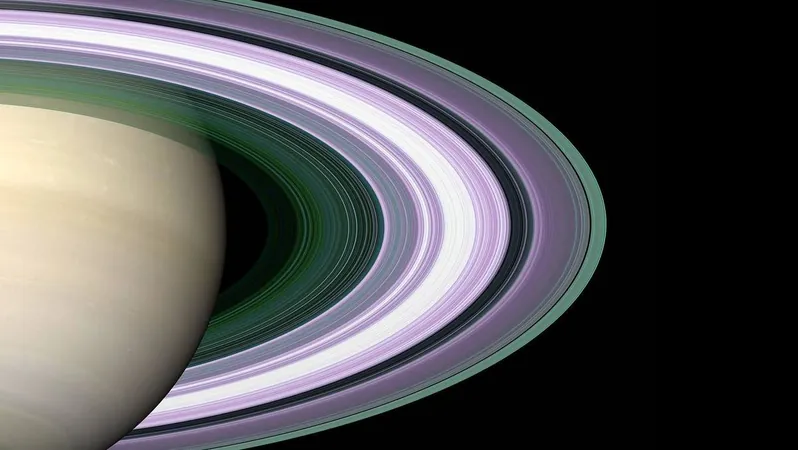
Saturn's Rings: A Surprising Revelation About Their Ancient Origins!
2024-12-16
Author: Arjun
Introduction
New research has overturned long-held beliefs about the age of Saturn's magnificent rings, suggesting they may be nearly as old as the planet itself, rather than a mere few hundred million years younger than dinosaurs, as previously thought.
Historical Debate on the Age of the Rings
The age of Saturn’s rings has sparked debate among scientists for years. Some experts initially proposed that these iconic, icy rings formed alongside Saturn around 4.5 billion years ago, resulting from the debris left in orbit after the solar system's formation. Conversely, others proposed a younger origin, suggesting the rings might have come from the remnants of a comet or a broken icy moon, torn apart by Saturn's immense gravitational pull.
Cassini Mission Observations
During NASA's Cassini mission, which reached Saturn in 2004, researchers observed that the rings appeared relatively clean and bright. Initial analyses estimated their age to be between 100 million and 400 million years, notably younger than the dinosaurs, which roamed the Earth approximately 230 million years ago.
Challenging the Youthful Perspective
However, the idea of such youthfulness for the rings of a long-established solar system seemed counterintuitive to Ryuki Hyodo, a planetary scientist at the Institute of Science in Tokyo. “The dynamic fate of the solar system during its early years was far more tumultuous,” Hyodo explained, pointing to the Late Heavy Bombardment era when many planetary bodies were moving chaotically and increasing the likelihood of significant events that could lead to the formation of Saturn's rings.
Advanced 3D Modeling
To probe deeper into this mystery, Hyodo and his team developed advanced 3D computer models that simulated the impacts of micrometeoroids—tiny space rocks colliding with the rings at staggering speeds of up to 67,100 mph (108,000 km/h). The data revealed that these fast-paced impacts could generate extreme temperatures, exceeding 17,540 degrees F (9,725 degrees C), leading to the vaporization of micrometeoroids. The resulting gases would expand and eventually cool within Saturn's magnetic field, creating charged ions and tiny particles.
Misinterpretation of Cleanliness
Interestingly, the research showed that much of this material did not pollute the rings, leading to a misinterpretation of their apparent cleanliness as a sign of youth. 'A pristine appearance does not strictly mean the rings are young,' Hyodo remarked, noting that their current analyses suggested the opposite.
Reevaluating Cassini Data
The study doesn't dismiss previous insights from the Cassini mission but suggests a reevaluation of the data's interpretation. The research implies the rings could indeed be ancient, with ages ranging between 4.5 billion to 4 billion years old.
Future Explorations
Hyodo and his colleagues are now conducting laboratory tests to simulate micrometeoroid impacts on icy particles to further validate their findings. Moreover, with ambitious visions for the future, Hyodo is leading multiple Japanese planetary exploration missions, focusing on a potential mission that could closely study Saturn's enigmatic rings. Such a mission would enable researchers to approach the rings more closely than Cassini, allowing for direct observations of impact events and gathering indirect evidence that could illuminate the rings' age.
Conclusion
As Saturn continues to hold secrets about its formation and history, experts are eager to uncover the mysteries that lie within its stunning, ancient rings. The implications of these findings extend beyond Saturn, potentially affecting our understanding of the rings of Uranus and Neptune and their icy moons. Will future explorations finally answer the age-old question about the origins of Saturn's rings? Only time—and scientific inquiry—will tell!



 Brasil (PT)
Brasil (PT)
 Canada (EN)
Canada (EN)
 Chile (ES)
Chile (ES)
 España (ES)
España (ES)
 France (FR)
France (FR)
 Hong Kong (EN)
Hong Kong (EN)
 Italia (IT)
Italia (IT)
 日本 (JA)
日本 (JA)
 Magyarország (HU)
Magyarország (HU)
 Norge (NO)
Norge (NO)
 Polska (PL)
Polska (PL)
 Schweiz (DE)
Schweiz (DE)
 Singapore (EN)
Singapore (EN)
 Sverige (SV)
Sverige (SV)
 Suomi (FI)
Suomi (FI)
 Türkiye (TR)
Türkiye (TR)